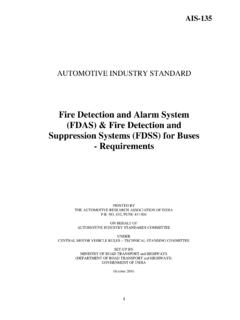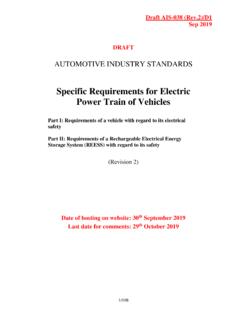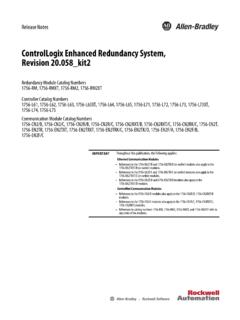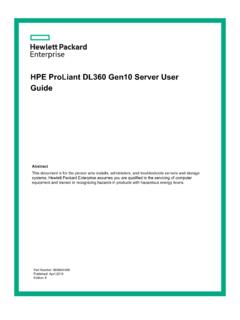Transcription of AUTOMOTIVE INDUSTRY STANDARD - ARAI India
1 AIS-137 (Part 3) I AUTOMOTIVE INDUSTRY STANDARD Test Method, Testing Equipment and Related Procedures for Type Approval and Conformity of Production (COP) Testing of M and N Category Vehicles having GVW not exceeding 3500 kg for Bharat Stage VI (BS VI) Emission Norms as per CMV Rules 115, 116 and 126 PRINTED BY THE AUTOMOTIVE RESEARCH ASSOCIATION OF India NO. 832, PUNE 411 004 ON BEHALF OF AUTOMOTIVE INDUSTRY STANDARDS COMMITTEE UNDER CENTRAL MOTOR VEHICLE RULES TECHNICAL STANDING COMMITTEE SET-UP BY MINISTRY OF ROAD TRANSPORT & HIGHWAYS (DEPARTMENT OF ROAD TRANSPORT & HIGHWAYS) GOVERNMENT OF India April 2019 AIS-137 (Part 3) II Status chart of the STANDARD to be used by the purchaser for updating the record Sr. No. Corrigenda Amendment Revision Date Remark Misc. General Remarks: AIS-137 (Part 3) III INTRODUCTION In India , the mass emission norms based on Indian Driving Cycle (IDC) were notified under CMVR in 1989.
2 The first mass emission norms for vehicles were enforced from 1st April 1991 for Gasoline vehicles and from 1st April 1992 for Diesel vehicles. Since then, progressively emission norms have been tightened. Government of India has notified migration to Bharat Stage VI (BS VI) emissions norms for 2, 3 and 4 wheeled vehicles from 1st April 2020. For Agricultural Tractors, Construction Equipment Vehicles and Combine Harvesters (vehicles having power exceeding 37 kW) next stage emission norms Bharat Stage (CEV/TREM) IV) are notified from 1st October 2020 and Bharat Stage (CEV/TREM) V) from 1st April 2024. Test procedure for Type Approval and CoP for above emission norms shall be as per various parts of AIS-137, as applicable. This Part 3 of AIS-137 prescribes Test Method, Testing Equipment and related procedures for Type Approval and Conformity of Production (COP) Testing of Vehicles of Category M and N having GVW not exceeding 3,500 kg for BS VI emission norms as per CMV Rules 115, 116 and 126.
3 Chapter 20 on Verifying Real Driving Emissions (RDE) will be included after finalized recommendations of the Indian Real Driving Emissions (IRDE) Committee are adopted. While preparing this STANDARD , considerable assistance has been taken from following regulations/documents: i) UN R 83 (Supplement 3 to the 07 series of amendments Date of entry into force: 9 February 2017): Uniform provisions concerning the approval of vehicles with regard to the emission of pollutants according to engine fuel requirements. ii) Regulation (EC) No 715/2007 of The European Parliament and of the Council of 20 June 2007 on type approval of motor vehicles with respect to emissions from light passenger and commercial vehicles (Euro 5 and Euro 6) and on access to vehicle repair and maintenance information iii) Commission Regulation (EC) No. 692/2008 of July 18, 2008 implementing and amending Regulation (EC) No. 715/2007 of the European Parliament and of the Council on type-approval of motor vehicles with respect to emissions from light passenger and commercial vehicles (Euro 5 and Euro 6) and on access to vehicle repair and maintenance information.
4 (Including Corrigendum) *As amended by Commission Regulations (EU) 566/2011, 459/2012, 630/2012, 143/2013, 195/2013, 136/2014, 2015/45, 2016/427, (EU) 2016/646, (EU) 2017/1151 and (EU) No. 2017/1221 AIS-137 (Part 3) IV iv) Commission Regulation (EU) 2017/1154 of 7 June 2017 amending Regulation (EU) 2017/1151 supplementing Regulation (EC) No 715/2007 of the European Parliament and of the Council on type-approval of motor vehicles with respect to emissions from light passenger and commercial vehicles (Euro 5 and Euro 6) and on access to vehicle repair and maintenance information, amending Directive 2007/46/EC of the European Parliament and of the Council, Commission Regulation (EC) No 692/2008 and Commission Regulation (EU) No 1230/2012 and repealing Regulation (EC) No 692/2008 and Directive 2007/46/EC of the European Parliament and of the Council as regards real-driving emissions from light passenger and commercial vehicles (Euro 6) v) UN Regulation 101 (Supplement 6 to the 01 series of amendments.
5 Date of entry into force ) : Uniform provisions concerning the approval of passenger cars powered by an internal combustion engine only, or powered by a hybrid electric power train with regard to the measurement of the emission of carbon dioxide and fuel consumption and/or the measurement of electric energy consumption and electric range, and of categories M1 and N1 vehicles powered by an electric power train only with regard to the measurement of electric energy consumption and electric range vi) Doc. No.: MoRTH/CMVR/ TAP-115/116: Issue No.:4: Document on test method, testing equipment and related procedures for testing type approval and conformity of production (CoP) of vehicles for emission as per CMV Rules 115, 116 and 126. vii) Government of India , Gazette Notification 889 (E) dated 16th September, 2016 regarding implementation of Bharat Stage VI (BS VI) emission norms for 2, 3 and 4 wheeled vehicles.
6 The Committee Composition for formulation of this STANDARD is given in Annexure 1. After approval of the STANDARD by SCOE, The AUTOMOTIVE Research Association of India , (ARAI), Pune, being the Secretariat of the AIS Committee, has published this STANDARD . For better dissemination of this information ARAI may publish this STANDARD on their web site. ** AIS-137 (Part 3) V TABLE OF CONTENTS CHAPTER & APPENDIX NO. CONTENTS PAGE NO Chapter 1 Overall requirements 1/296 Appendix 1 Manufacturer's certificate of compliance with the OBD in-use performance requirements 38/296 Chapter 2 Essential characteristics of the vehicle and engine and information concerning the conduct of tests 39/296 Chapter 3 Type I Test: Verifying exhaust emissions after a cold start 40/296 Chapter 4 - Appendix 1 chassis dynamometer system 71/296 Appendix 2 Exhaust dilution system 75/296 Chapter 5 - Appendix 1 Verification of simulated inertia 88/296 Appendix 2 Measurement of vehicle road load resistance to progress of a vehicle measurement method on the road simulation on a chassis dynamometer 90/296 Chapter 6 Calibration of equipment for evaporative emission testing 99/296 Chapter 7 Gaseous emissions measurement equipment 105/296 Chapter 8 Appendix 1 Particulate mass emissions measurement equipment 114/296 Appendix 2 Particle number emissions measurement equipment 122/296 Chapter 9 Type II test and free acceleration smoke test 131/296 Chapter 10 Type III test: Verifying emissions of crankcase gases 134/296 Chapter 11 Type IV test: Determination of evaporative emissions from vehicles with positive- ignition engines 137/296 Chapter 12 Type V test.
7 Description of the endurance test for verifying the durability of pollution control devices 152/296 Appendix 1 STANDARD Bench Cycle (SBC) 161/296 Appendix 2 STANDARD Diesel Bench Cycle (SDBC) 167/296 Appendix 3 STANDARD Road Cycle (SRC) 168/296 AIS-137 (Part 3) VI Chapter 13 Granting of type approval for a vehicle fuelled by LPG or NG/Biomethane 171/296 Appendix 1 Bi-fuel vehicle Calculation of LPG energy ratio 175/296 Appendix 2 Bi-fuel vehicle Calculation of NG/ Biomethane energy ratio 176/296 Chapter 14 On-Board Diagnostics (OBD) for motor vehicles 177/296 Appendix 1 Functional aspects of On-Board Diagnostic (OBD) systems 189/296 Appendix 2 Essential characteristics of the vehicle family 203/296 Chapter 15 Emissions test procedure for a vehicle equipped with a periodically regenerating system 204/296 Chapter 16 Requirements for vehicles that use a reagent for the exhaust after-treatment system 213/296 Chapter 17 Emissions test procedure for Hybrid Electric Vehicles (HEV) 219/296 Appendix 1 Electrical energy/power storage device state of charge (SOC)
8 Profile for OVC HEV Type I test 235/296 Chapter 18 Appendix 1 In-service conformity check 236/296 Appendix 2 Statistical procedure for tailpipe emissions in-service conformity testing 242/296 Appendix 3 Responsibilities for in-service conformity 248/296 Chapter 19 Administrative and technical procedure for measurement and monitoring [average] fuel consumption in l/100 km of M1 category vehicles with GVW not exceeding 3,500 kg 249/296 Appendix 1 Annual fuel consumption report to be submitted by manufacturer 262/296 Appendix 2 Manufacturer s fuel consumption passbook 264/296 Appendix 3 Format of compliance 265/296 Appendix 4 Annual fuel consumption compliance report 266/296 Appendix 5 Definitions for CO2 reduction technologies 267/296 Chapter 19 A Determination of the emissions of carbon dioxide, fuel consumption and the electric energy consumption of vehicles powered by a hybrid electric power train 268/296 Appendix 0 Electrical energy/power storage device State of Charge (SOC) profile for OVC HEVs 286/296 AIS-137 (Part 3)
9 VII Appendix 1 Method for measuring the electricity balance of the REESS of OVC and NOVC HEVs 287/296 Appendix 2 Method of measuring the electric range of vehicles powered by a hybrid electric power train and the OVC range of vehicles powered by a hybrid electric powertrain 289/296 Chapter 20 Verifying Real Driving Emissions (RDE) (Reserved) 295/296 Annexure 1 Composition of a committee for formulation of this STANDARD as per MORTH Office Memorandum No. RT-11035/28/2015-MVL, dated 3rd September, 2015 296/296 AIS-137 (Part 3) 1/296 CHAPTER 1 OVERALL REQUIREMENTS SCOPE This part applies to the emission of vehicles equipped with positive-ignition engines including hybrids and compression - ignition engines including hybrids for all M and N category vehicles with GVW up to 3,500 kg for Bharat Stage VI. In addition, this Part lays down rules for in-service conformity, durability of pollution control devices, On-Board Diagnostic (OBD) systems, Real Driving Emission (RDE) and measurement of fuel consumption.
10 This Part shall apply to vehicles of categories M1, M2, N1 and N2 with a reference mass not exceeding 2,610 kg. At the manufacturer's request, type approval granted under this Part may be extended from vehicles mentioned above to M1, M2, N1 and N2 vehicles with a reference mass not exceeding 2,840 kg and which meet the conditions laid down in this Part. If a vehicle is tested for type approval on chassis dynamometer having reference mass up to 2,610 kg, manufacturer may seek type approval extensions up to reference mass of 2,840 kg for its variants, even if intended variant GVW exceeds beyond 3,500 kg. This Part should be read in conjunction with applicable Gazette Notification for which the vehicle is subjected to test. DEFINITIONS For the purposes of this Part the following definitions shall apply: "Reference mass" means the "unladen mass" of the vehicle increased by a uniform figure of 150kg "Unladen mass" means the mass of the vehicle in running order without the uniform mass of the driver of 75kg, passengers or load, but with the fuel tank 90 % full and the usual set of tools and spare wheel on board, where applicable; Gross Vehicle Weight (GVW) means the technically permissible maximum weight declared by the vehicle manufacturer.















